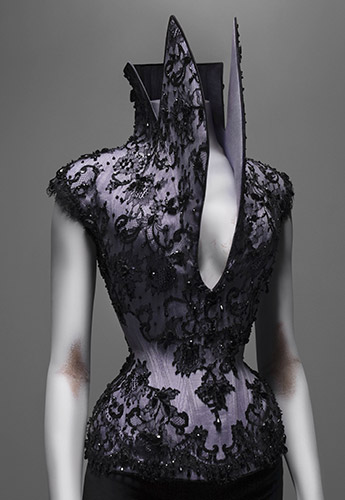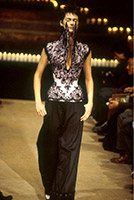Alexander McQueen (British, 1969–2010)
Corset
Dante, autumn/winter 1996–97
Lilac silk faille appliquéd with black silk lace and embroidered with jet beads
Courtesy of Alexander McQueen
Photograph © Sølve Sundsbø / Art + Commerce
Audio clip: Adobe Flash Player (version 9 or above) is required to play this audio clip. Download the latest version here. You also need to have JavaScript enabled in your browser.
The corset comes from his autumn/winter 1996–7 collection, called Dante. By this time, McQueen had gained an international reputation, but he was also still struggling to make a living. Louise Wilson, director of the MA program at Central Saint Martins, talks about those early years for McQueen—or Lee, as he is known to his friends:
Louise Wilson: There’s one thing you could say about Lee: he deserves every credit for what he did because it was incredibly hard when he left, and they had absolutely no money, and it was a very different time to now. And they lived in a squat. And although that all sounds very romantic, it was hell. And because of not having any money they took risks. And it sat outside of a fashion system.
Andrew Bolton: McQueen’s skill at making clothing helped him to succeed.
Louise Wilson: An architect doesn’t build the house for you; they employ the builders, whereas, Lee, in effect, built the house because he cut the patterns and he sewed the jackets. Basically, he didn’t need to depend on anybody. He didn’t have to employ a machinist. He didn’t have to employ a pattern-cutter at the very beginning. You know, if he had nothing he could still create.
In McQueen’s Words
“People find my things sometimes aggressive. But I don’t see it as aggressive. I see it as romantic, dealing with a dark side of personality.”
W, July 2002


 Vogue iPad app
Vogue iPad app
